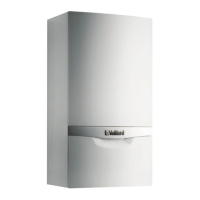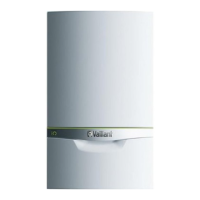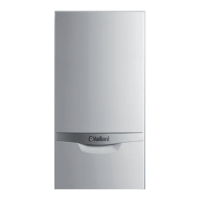Supplied By www.heating spares.co Tel. 0161 620 6677
14 Instructions for installation and servicing ecoTEC
3.7 Flue termination
The following details refer to both flue systems.
a. The terminal must be located where the combustible
substances can escape freely at all times.
b. A plume of water vapour will sometimes be visible
from the flue terminal. Positions where this could be
a nuisance should be avoided.
c. If the terminal is fitted less than 2 m above a balcony,
above ground or above a flat roof to which people
have access then a suitable terminal guard must be
provided and fitted (made by Tower Flue
Components, Tonbridge, TN9 1TB, Model K3, plastic
coated).
A
BCD
A
G
H, I
F
J
B
F
M
L
L
K
K
G
G
F
F
E
A
A
Fig. 3.8 Flue termination
Note
Vertical flues must not terminate within
600 mm of an openable window, air vent or any
other ventilation opening.
The flue assembly shall be so placed or shielded as to
prevent ignition or damage to any part of the building.
Terminal position mm
A
Directly below an opening, above an opening or hori-
zontal to an opening, air brick, opening window, etc.
300
B Below gutters, soil pipes or drain pipes 75
C Below eaves 200
D Below balconies 200
E From vertical drain pipes and soil pipes 25
F From internal or external corners 300
G Above ground, roof or balcony 300
H From a surface facing a terminal 600
I From a terminal facing a terminal 1200
J From an opening (e.g. door, window) into the dwelling 1200
K Vertically from a terminal on the same wall 1500
L Horizontally from a terminal on the same wall 300
M Distance from adjacent for vertical Flue 500
Table 3.4 Terminal position for a fan assisted concentric flue
Note
In addition, the terminal should not be nearer
than 150 mm to an opening in the building fab-
ric formed for the purpose of accommodating a
built-in element such as a window.
BS 5440–1: It is recommended that the fanned flue ter-
minal should be positioned as follows:
a) at least 2 m from an opening in the building directly
opposite, and
b) so that the products of combustion are not directed
to discharge across a boundary.
1) Dimensions B, C and D:
These clearances may be reduced to 25 mm without
affecting the performance of the boiler. In order to
ensure that the condensate plume does not affect
adjacent surfaces the terminal should be extended as
shown in Fig. 3.9.
2) Dimension F:
This clearance may be reduced to 25 mm without
affecting the performance of the boiler. However, in
order to ensure that the condensate plume does not
affect adjacent surfaces a clearance of 300 mm is
preferred. For IE, recommendations are given in the
current edition of IS 813.
Fig. 3.9 Flue termination under balcony/eaves
3.8 Air supply
Detailed recommendations for air supply are given in
BS 5440: Part 2.
It is not necessary to have an air vent in the room or
internal space in which the boiler is installed.
Cupboard or compartment ventilation
The boilers are very high efficiency appliances. As a con-
sequence the heat loss from the appliance casing during
operation is very low. For cupboard or compartment
installations it is therefore not necessary to provide any
high or low level permanent air vents for cooling purpos-
es.
3 General requirements

